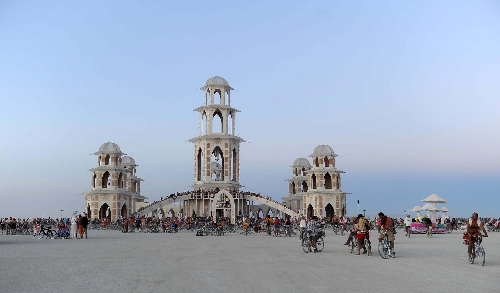Burning Man festival keeps spark 25 years on
BLACK ROCK CITY -- Burning Man started 25 years ago as a gathering of friends and strangers on San Francisco's Baker Beach.
It was a random act of public art, including an 8-foot-tall wooden man burning against the Northern California sunset, 20 people clasping hands around it.
Fast forward to 2011. The annual event -- marked by public art, self-expression and an eight-day experiment in community -- sold out for the first time in its history. Ticket sales hit the 50,000-person limit the U.S. Bureau of Land Management allows for Black Rock City, the temporary home of Burning Man located on a dry lake bed two hours northeast of Reno.
Clearly, things have changed.
Many longtime observers say Burning Man has become more desert metropolis than Thunderdome during the past 15 years, with more rules and restrictions. But they also say the fundamental things that define Burning Man are still intact.
Brian Doherty has been making the annual trek to Black Rock City since 1995. In 2004, he wrote the book, "This Is Burning Man," which chronicles the event's history, organizers and culture.
The literal lawlessness that marked Burning Man's early years in the Nevada desert has tamed, Doherty said shortly before the 2011 event began. There are no more "drive-by shooting ranges," for example.
What hasn't changed, Doherty said, is the "social lawlessness" that can compel a mild-mannered accountant to roll naked in playa mud without fear of consequences (save for an uncomfortable alkali burn).
"I don't think for that person, the actual experience of being there will be much different from being there five or 10 years ago," said Doherty, who also works as senior editor of Reason magazine.
If there was a watershed moment for Burning Man, Doherty said, it was 1998, when Black Rock City got street signs and developed its half-circle layout, which is getting closer to a full circle with the increasing population.
Black Rock City implemented one change in 2009 that struck Doherty as particularly egregious: Early arrivals to Burning Man were given a bar code to be scanned before they could enter. It was a little too "Big Brother," Doherty said.
And if you're not gone by the day after Burning Man ends, someone is likely to ask why you're still there, he said.
"It's gotten a lot more rule-bound, but I don't think those rules have affected the normal citizen," Doherty said.
Danielle Gann-Lind, 43, from Reno, who has gone to Burning Man every year since 2000, said it's inevitable some Burners will sing the event's death knell each year.
"There's a hard-core group of Burners who always come back every year and say, 'Oh, it was better last year; Burning Man sucks; I'm not going this year,' " Gann-Lind said. "But I get asked all the time, 'What's your favorite year?' And to me, it's sort of like comparing apples to oranges because each year has its own participants, its own theme."
Sure, there are more restrictions compared with the 1990s, from not driving during the event to using one-ply toilet paper so the portable bathrooms don't get clogged, among other rules laid out in Burning Man's "survival guide."
Gann-Lind said those rules are a sign the organization is growing up, dealing with problems that would affect any municipality.
"We are so fortunate that this occurs in our backyard," she said. "It is becoming a part of culture, which hopefully makes people think that maybe there's a better way of doing things, or at least a different way of doing things."
While shopping for Burning Man accessories last week, Alicia Hamilton, 34, said the event is largely the same compared with her first time going in 2001.
She noted the strict adherence to "leave no trace" and the no-commerce ethos that's marked Burning Man since its beginning.
Participants are not allowed to buy or sell anything in Black Rock City.
"A lot of people that have never actually been are hearing things like ... it's getting so commercial," Hamilton said. "The only thing they sell out there is ice (and coffee). How commercial can it be?"

















